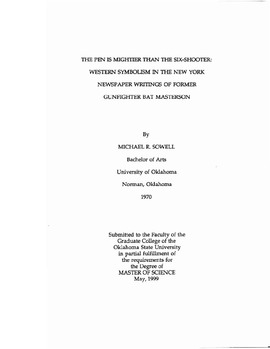| dc.description.abstract | Bat Masterson, once one of the most feared gunfighters in the American West, died not with a six-shooter in his hand but with perhaps a more powerful weapon - the pen. Although best known in history as a colorful lawman and gambler in the untamed boom towns of the frontier, Masterson spent the last two decades of his life as a New York newspaper reporter and sports editor. This hero of the West, who owed his fame in great part to the newspaper writings of his exploits on the frontier, in the latter part of his life was himself a journalist, chronicling the exploits not of gunfighters and desperadoes but of some of the most famous athletes of the early twentieth century. As a newspaper columnist, Masterson had a greater forum for his views and more influence than he ever did as a lawman or gunfighter. While it is significant to examine why a former gunfighter was given such a platform, it is of greater importance to study how he used this forum and what his writings can tell us about that period of American history from the final days of the frontier in the late nineteenth century to the urbanization of America that continued through the time of Masterson's death in 1921. The attempt to understand the how and what of Masterson's newspaper writings is the guiding force behind this work. Rather than accepting Masterson's role as a sports reporter as merely a footnote in American history, this project begins with the premise that by examining Masterson's writings within the context of the greater events of his era, one can gain a unique insight into American society at this time. Masterson was a product of the American West and the mythology of the frontier, yet later in his life he became symbolic of another great event in American history the rural-to-urban movement. Were these events and these themes reflected in the writings of this one-time gunfighter, and if so how? The nature of this research requires a preliminary discussion of the methodology that will be employed. The primary sources which will be used are Masterson's published columns and articles. In this regard, the research will contain elements of content analysis, as it will follow a systematic approach to examining and attempting to quantify certain themes and elements in his writing. However, as Arthur Schlesinger, Jr., has observed, "almost all the important questions [in history) are important precisely because they are not susceptible to quantitative answers."1 Thus, the content analysis of Masterson's writing is meant only to "suggest or hint what motives or relationships might be."2 This is a methodology which has been practiced in communication research, where quantitative methods often are well suited to study topics such as a journalist's attitudes, as is being done here. A more detailed explanation of the methodology used is given in Chapter 5. However, it should be mentioned here that the "road map" followed in this research project was that provided by James D. Startt and Wm. David Sloan, who propose five "controls" in attempting to do interpretation in history. Briefly summarized, these are: There must be some logical criteria for the selection of the evidence used; The evidence must be studied in historical context (or, "a sense of historical time"); The study must include the opinions of others on the topic; Not only must "general statements rest on evidence..." but "[specific material must be related to generalization "; An effort must be made to transcend the present time and circumstances in order to examine Masterson by the standards of his day.3 Even in the newsroom, just as on the frontier, Masterson was a man who inspired not only fear and curiosity but above all respect. No doubt, his reputation as an old West gunman had much to do with the respect his newspaper column commanded. Still, as was noted in the rival New York Tribune, Masterson wrote with a "directness of expression" that resulted in stories and columns that contained within them valuable insights into America and American culture as Masterson saw them in this unique period of our history. From an historian's standpoint, the writings by Masterson may tell us more about America than the many writings and tall tales about him. | |
